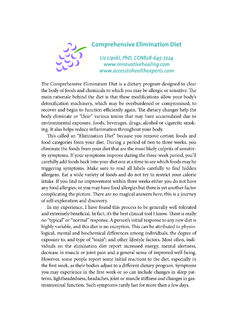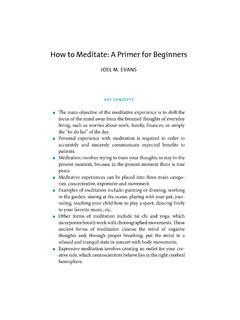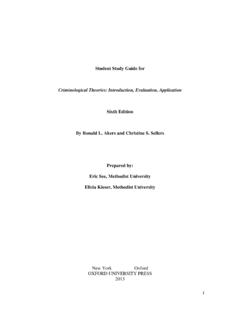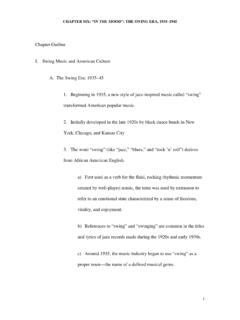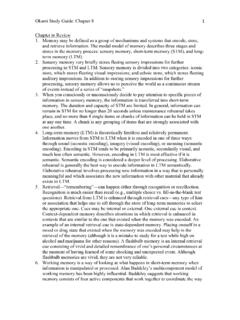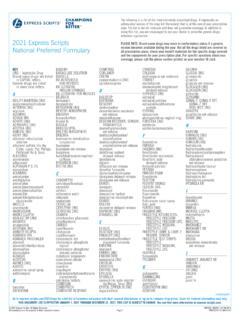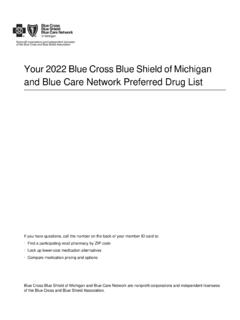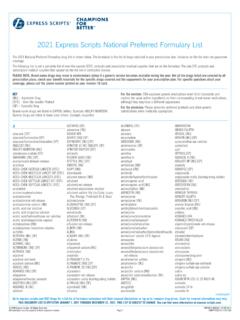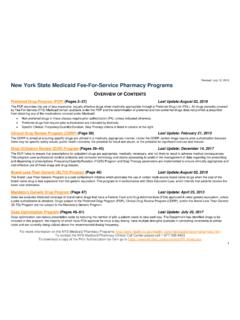Transcription of Chapter 9 Mutually Exclusive Alternatives
1 127 Chapter 9 Mutually Exclusive Alternatives 9-1 Using a 10% interest rate, determine which alternative, if any, should be selected, based on net present worth. Alternative A B First Cost $5,300 $10,700 Uniform Annual Benefit 1,800 2,100 Useful life 4 years 8 years Solution Alternative A: NPW = 1,800(P/A, 10%, 8) - 5,300 - 5,300(P/F, 10%, 4) = $ Alternative B: NPW = 2,100(P/A, 10%, 8) - 10,700 = $ Select alternative A 9-2 Three purchase plans are available for a new car. Plan A: $5,000 cash immediately Plan B: $1,500 down and 36 monthly payments of $ Plan C: $1,000 down and 48 monthly payments of $ If a customer expects to keep the car five years and her cost of money is 18% compounded monthly, which payment plan should she choose?
2 Solution 128 Chapter 9 Mutually Exclusive Alternatives i = 18/12 = 1 % PWA = $5,000 PWB = 1,500 + (P/A, 1 %, 36) = $4, PWC = 1,000 + (P/A, 1 %, 48) = $5, Therefore Plan B is the best plan. 9-3 Given the following three Mutually Exclusive Alternatives Alternative A B C Initial Cost $50 $30 $40 Annual Benefits 15 10 12 Useful Life (years) 5 5 5 What alternative is preferable, if any, assuming i = 10%? Solution PWA = -50 + 15(P/A, 10%, 5) = $ PWB = -30 + 10(P/A, 10%, 5) = $ PWC = -40 + 12(P/A, 10%, 5) = $ Choose C 9-4 Consider two investments: 1. Invest $1,000 and receive $110 at the end of each month for the next 10 months. 2. Invest $1,200 and receive $130 at the end of each month for the next 10 months.
3 If this were your money, and you want to earn at least 12% interest on your money, which investment would you make, if any? Solve the problem by annual cash flow analysis. Solution Alternative 1: EUAW = EUAB - EUAC = 110 - 1,000(A/P, 1%, 10) = $ Alternative 2: EUAW = EUAB - EUAC = 130 - 1,200(A/P, 1%, 10) = $ Maximum EUAW, therefore choose alternative A. 9-5 A farmer must purchase a tractor using a loan of $20,000. The bank has offered the following choice of payment plans each determined by using an interest rate of 8%. If the farmer's minimum attractive rate of return (MARR) is 15%, which plan should he choose? Plan A: $5,010 per year for 5 years Chapter 9 Mutually Exclusive Alternatives 129 Plan B: $2,956 per year for 4 years plus $15,000 at end of 5 years Plan C: Nothing for 2 years, then $9,048 per year for 3 years Solution PWCA = 5,010(P/A, 15%, 5) = $16,794 PWCB = 2,956(P/A, 15%, 4) + 15,000(P/F, 15%, 5) = $15,897 PWCC = 9,048(P/A, 15%, 3)(P/F, 15%, 2) = $15,618 Plan C is lowest cost plan 9-6 Projects A and B have first costs of $6,500 and $17,000, respectively.
4 Project A has net annual benefits of $2,000 during each year of its 5-year useful life, after which it can be replaced identically. Project B has net annual benefits of $3,000 during each year of its 10-year life. Use present worth analysis, and an interest rate of 10% to determine which project to select. Solution PWA = -6,500[1 + (P/F, 10%, 5)] + 2,000(P/A, 10%, 10) = $1, PWB = -17,000 + 3,000(P/A, 10%, 10) = $ 1, Select A because of higher present worth 9-7 A manufacturing firm has a minimum attractive rate of return (MARR) of 12% on new investments. What uniform annual benefit would Investment B have to generate to make it preferable to Investment A? Year Investment A Investment B 0 - $60,000 - $45,000 1 - 6 +15,000 ?
5 Solution NPW of A = - 60,000 + 15,000(P/A, 12%, 6) = $1,665 NPW of B 1,665 = - 45,000 + A(P/A, 12%, 6) A = 11,351 Annual Benefit > $11,351 per year 130 Chapter 9 Mutually Exclusive Alternatives 9-8 The city council wants the municipal engineer to evaluate three Alternatives for supplementing the city water supply. The first alternative is to continue deep well pumping at an annual cost of $10,500. The second alternative is to install an 18" pipeline from a surface reservoir. First cost is $25,000 and annual pumping cost is $7000. The third alternative is to install a 24" pipeline from the reservoir at a first cost of $34,000 and annual pumping cost of $5000. Life of all Alternatives is 20 years.
6 For the second and third Alternatives , salvage value is 10% of first cost. With interest at 8%, which alternative should the engineer recommend? Use present worth analysis. Solution Fixed output, therefore minimize cost. Year DEEPWELL 18" PIPELINE 24" PIPELINE 0 -25,000 -34,000 1-20 -10,500 -7,000 -5,000 20 +2,500 +3,400 Deepwell: PWC = - 10,500(P/A, 8%, 20) = -$103,089 18" Pipeline: PW of Cost = -25,000 - 7,000(P/A, 8%, 20) + 2,500(P/F, 8%, 20) = -$93,190 24" Pipeline: PW of Cost = -34,000 - 5,000(P/A, 8%, 20) + 3,400(P/F, 8%, 20) = -$82,361 Choose 24" Pipeline 9-9 An engineering analysis by net present worth (NPW) is to be made for the purchase of two devices A and B. If an 8% interest rate is used, recommend the device to be purchased.
7 Cost Uniform Annual Benefit Salvage Useful Life Device A $600 $100 $250 5 years Device B 700 100 180 10 years Solution Device A: NPW = 100(P/A, 8%, 10) + 250(P/F, 8%, 10) - 600 - [600 - 250](P/F, 8%, 5) = -$ Device B: NPW = 100(P/A, 8%, 10) + 180(P/F, 8%, 10) - 700 = $ Select device B 9-10 Chapter 9 Mutually Exclusive Alternatives 131 Two Alternatives are being considered for recovering aluminum from garbage. The first has a capital cost of $100,000, a first year maintenance cost of $15,000, with maintenance increasing by $500 per year for each year after the first. The second has a capital cost of $120,000, a first-year maintenance cost of $3000, with maintenance increasing by $1,000 per year after the first.
8 Revenues from the sale of aluminum are $20,000 in the first year, increasing $2,000 per year for each year after the first. Life of both Alternatives is 10 years. There is no salvage value. The before-tax MARR is 10%. Using present worth analysis, determine which alternative is preferred . Solution Alternative 1: NPW = -100,000 + 15,000(P/A, 10%, 10) + 500(P/G, 10%, 10) = $3, Alternative 2: NPW = -120,000 + 17,000(P/A, 10%, 10) + 1,000(P/G, 10%, 10) = $7, Choose Alternative 2 Maximum. NPW 9-11 A brewing company is deciding between two used filling machines as a temporary measure, before a plant expansion is approved and completed. The two machines are: (a) The Kram Filler. Its initial cost is $85,000, and the estimated annual maintenance is $8000.
9 (b) The Zanni Filler. The purchase price is $42,000, with annual maintenance costs of $8000. The Kram filler has a higher efficiency, compared with the Zanni, and it is expected that the savings will amount to $4000 per year if the Kram filler is installed. It is anticipated that the filling machine will not be needed after 5 years, and at that time, the salvage value for the Kram filler would be $25,000, while the Zanni would have little or no value. Assuming a minimum attractive rate of return (MARR) of 10%, which filling machine should be purchased? Solution Fixed output, therefore minimize costs Kram: NPW = 25,000(P/F, 10%, 5) - 85,000 - 4,000(P/A, 10%, 5) = -$84, (or a PWC $84, ) Zani: NPW = -42,000 - 8,000(P/A, 10%, 5) = -$72,328 (or a PWC of $72,328) Therefore choose the Zani filler.
10 9-12 Two technologies are currently available for the manufacture of an important and expensive food 132 Chapter 9 Mutually Exclusive Alternatives and drug additive. The two can be described as follows: Laboratory A is willing to release the Exclusive right to manufacture the additive in this country for $50,000 payable immediately, and a $40,000 payment each year for the next 10 years. The production costs are $ per unit of product. Laboratory B is also willing to release similar manufacturing rights. They are asking for the following schedule of payments: On the closing of the contract, $10,000 From years 1 to 5, at the end of each year, a payment of $25,000 each From years 6 to 10, also at the end of each year, a payment of $20,000.
